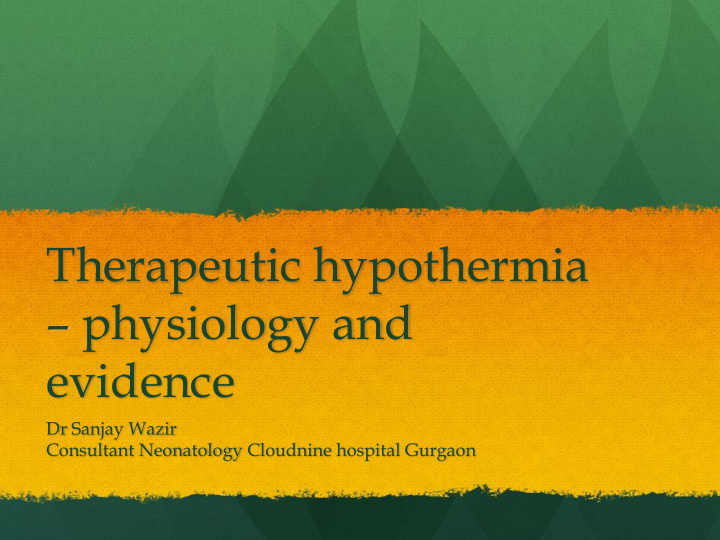



Therapeutic hypothermia – physiology and evidence Dr Sanjay Wazir Consultant Neonatology Cloudnine hospital Gurgaon
Objectives – hypothermia treatment Why hypothermia Does it work especially the low cost options How to do it Which babies to be put into treatment
Global burden
Disease model So not all babies who did not cry at birth need treatment
Target mechanisms in asphyxia Multiple interventions have been tried but most have not shown benefit
Hypothermia has a sustained benefit
Temp Range- major trials NICHD trial- 33.4 ± 0.4 °C TOBY trial – 33.5 ± 0.5 °C ICE trial – 33.8 ± 0.4 °C This is the basis why most trails have stuck to this range
Phases of cooling Induction • Earlier the cooling, better outcome • Passive cooling post reusus • Neuro exam before induction • ? Speed of induction • Overshoot common Techniques for therapeutic hypothermia during transport and in hospital for perinatal asphyxial encephalopathy. Nicola J. Robertson, Giles S. Kendall, Sudhin Thayyil
Phases of cooling Maintenance 33-34 C Prevent fluctuations- servo better Avoid cold injury to skin Prevent displacement of temp probe Nursing Monitoring
Phases of cooling Re-warming Slow 0.2-0.5 C/hr NO rapid rewarming Adult studies-poor outcome ? Hypotension due to vasodilatation or hyperkalema/hypoglycem ia Rebound seizures reported Not reported in RCT’s Monitor few hours after normothermia to prevent rebound hyperthermia
Cooling Equipment-manual and semi-automated devices Techniques for therapeutic hypothermia during transport and in hospital for perinatal asphyxial encephalopathy. Nicola J. Robertson, Giles S. Kendall, Sudhin Thayyil
Cooling Equipment- Automated (servo) devices Techniques for therapeutic hypothermia during transport and in hospital for perinatal asphyxial encephalopathy. Nicola J. Robertson, Giles S. Kendall, Sudhin Thayyil
Cooling equipment-low cost devices Passive cooling Cool gel/Ice packs Fans Water bottles Phase-changing material
Passive cooling • 18 babies cooled passively • Room temp 24 C • Barbiturate, opiates and benzodiazepams used if temp not coming down • Then active cooling with cool gel packs • 4/18 (22%) did not require any active cooling at all. • 14 newborns (78%) were actively cooled with ice packs over a total of 9.6 ± 7.5 hours Daetwyler K et al. Feasibility and safety of passive cooling in a cohort of asphyxiated newborn infants. Swiss Med Wkly. 2013;143:w13767
Cool gel/Ice Packs Thomas et al-Indian Pediatr. 2011 Jun 7;48(6):445-51 Cloth covered ice gel packs in 20 babies- Induction achieved -mea ± n 52 mins), stable maintenance 33.01 ± 0.4 and smooth re-warming (0.48 ± 0.07C)
Monitoring -Clinical Temperature- continuous core (rectal/esophageal) and skin Record q15 mins for 1 st 4 hour, then q1h Vitals- continuous HR, SPO2, BP and urine output Should have ECG leads, invasive BP-art line/UA, Central access (UV) as far as possible, SPO2 monitoring, Urinary cath/bag Record hourly Change position and check skin for cold injury q4h
Inclusion Criteria for Brain Cooling A.GA > 35 Wks /Birth Weight > 1800 Gms /<6 Hrs of age B. Physiological criteria – Any1 of following 1.ABG (UC/1 st postnatal hr) PH<7 or ABE > -12 2. Apgar score <5 at 5 min 3.Ventilation required for at Least 10 min C. Neurological Criteria : Seizure or Evidence of Moderate and Severe encephalopathy (3 of 6 criteria in modified Criteria)
MODIFIED SARNAT ’ S STAGING Shankaran et al. NICHD trial NEJM 2005
OUTBORN 1.GA > 35 wks / Birth Weight > 1800 g/ < 6 hrs of age 2. Physiological Criteria – Newborn who did not cry immediately after Birth/ Required resuscitation/APGAR score < 5 at 5 min(if avail.) 3. Neurological Criteria – Seizures or evidence of encephalopathy The newborn should fulfill criteria 1, 2,and 3.If not ,do not use the product Department of Neonatology , Christian Medical College, Vellore, India
Exclusion Criteria > 6 hours of age Major congenital abnormalities, Imperforate anus significant head trauma or skull fracture Coagulopathy with active bleeding Severe PPHN/ possible need for NO Infants < 1,800g-birth weight
Stopping cooling prior to 72 hours Persistent hypoxemia in 100 % oxygen Life threatening coagulopathy Arrthymia requiring medical treatment (not sinus bradycardia) Decision on withdrawal of care-signs of irreversible brain damage
Clinical Monitoring Heart rate Q 1hrly Respiratory Rate Q 1hrly Blood pressure Q 1hrly Spo2 Q 1hrly – more frequent if hypotensive Rectal Temperature Q 1hrly Skin Temp Q 1hrly Neurological examination At recruitment prior to cooling and q 24 hrly till normal and discharge(Thompson scoring) Urine Output Q 6hrly Skin Beakdown/redness Q 4 hrly
Lab Monitoring Baseline 24 hrs 48 hrs 72 hrs S. Electrolyte Y Y Blood urea Y Y S. Creatinine Y Y Blood sugar PT/APTT Y Y Y Y Hb, TLC, Y Y Y DLC,Plt. SGOT/SGPT Y ECG When Clinically Indicated HR < 80/min
NEUROLOGICAL MONITORING Neurological assessment at least once a day till rewarming- eg Sarnat/Thompson Formal eg Amiel-Tison/Hammersmith NNE/TIMP (test for infant motor performance) at 1 week or discharge aEEG Neuroimaging -Ultra sound/MRI with MRS
ADVERSE OUTCOME Sclerema and Subcutaneous fat necrosis Skin erythema Pulmonary hemorrhage Renal failure Increased blood viscosity- hemoconcentration, hyperviscosity DIC Hypoglycemia Acid-base and electrolyte disturbances Increased risk of infections Hypotension- marked decrease in myocardial contractility and cardiac output in experimental animal models Sudden cardiac arrest, VT,VF Pulmonary vasoconstriction.
Conclusion Asphyxia - huge burden but now interventions for reduction available Selection of babies is key to optimum outcome Servo controlled devices are good but expensive Low cost models are available – look very promising but would need long term data
THANK YOU
Recommend
More recommend